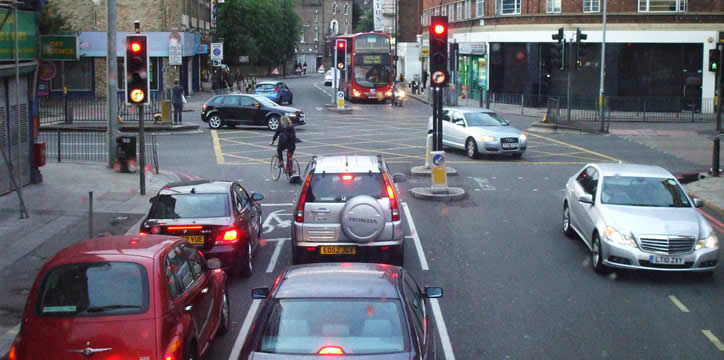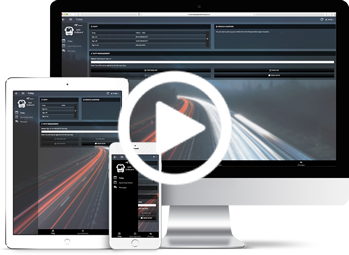Is Technology a Secret Congestion Killer?
The recent UK Bus Summit confirmed that congestion remains a hot topic in public transport, with particular focus on the link between falling bus speeds and decreasing ridership.
So how can we keep our buses moving?
Aside from the obvious tools – bus lanes and congestion zones – some Trapeze customers have had success tackling congestion by extending bus stop clearways, raising curbs and moving stops to reduce boarding times; replacing speed bumps with speed cushions, and adjusting parking enforcement strategies.
But is there also a role for technology? Let’s first consider the tools that can help us to cope with congestion, and then look at ways we could ease congestion itself.
Coping with Congestion
1. Improve Traffic Light Priority
Traffic Light Priority (TLP) can reduce the impact of congestion by offering buses priority through junctions. However, though effective, there has historically been a limitation that the on-bus equipment can instigate a TLP request, but there was no way to receive feedback to show whether the request was acted upon, or even received.
At Trapeze we have been working to improve this process, and alongside the relevant RTIG group we have been able to drive through a change to the RTIG T031 protocol (version 1.1), which supports traffic management system responses.
We have adopted this in the latest version of Novus-RT so that local authority staff can see whether responses have been received and acted upon, empowering them to work with their traffic management supplier to establish improvements that deliver maximum benefit from the TLP system, thereby reducing the impact of congestion on bus services.
Chris Bainbridge from First Group Hampshire has enjoyed significant success by working with the Local Authority to implement tweaks to the lights at a particularly troublesome junction, thereby enabling the team to optimise movement through the junction. Chris and the team were able to use the data in Novus-RT to take a scientific reporting approach to Traffic Light Priority.
This exercise has improved First Group Hampshire’s ability to cope with congestion – something that all organisations will be better equipped to do with the recent changes in Novus-RT and RTIG T031 version 1.1.
2. Use Real-Time Validation data to improve schedules
Do you know for sure that your schedules are optimal? We recently created a Real-Time Validation module for our Novus Real-Time solution, which allows users to overlay real-time data on top of schedules to analyse the effectiveness of current schedules.
This helps transport providers to deal with congestion by making it easy to pinpoint instances where localised congestion is affecting schedule accuracy, and take appropriate steps to make them better.
3. Dynamic Scheduling
Improving schedule accuracy is great, but advances in computer technology are starting to increase the scope of what is possible. What if we could take scheduling to the next level, and actually build schedules from the ground up to take into account the information received from trip timing points?
We believe Dynamic Scheduling is the next evolution of scheduling, enabling transport providers to mathematically optimise schedules with the best possible understanding of the impact of congestion on timetables.
Reducing Congestion
1. Identify and address sub-optimal bus routes
Technology can already help planning staff to review routes and identify potential improvements. We know of clients who regularly use their real-time solution to analyse the effectiveness of routes that are being run.
In some instances this simple act has made it possible to identify problematic routes that have quickly been adjusted, shaving minutes off some routes; thereby getting passengers to their destination quicker, and saving bus operators hundreds of thousands of pounds at the same time.
2. Improve at-stop publicity
One Trapeze customer has had success reducing boarding times by implementing simple changes to at-stop publicity: by ensuring printed materials provide passengers with clear information relating to concessionary travel times and which services visit local points of interest (train stations, hospitals etc.) it has been possible to reduce departure delays caused by conversations between drivers and confused passengers.
This is especially topical at the moment, due to recent improvements in printed publicity. Modern outputs – such as those produced by Trapeze’s Novus-Publish – make it possible to generate highly customised layouts that entirely satisfy passengers’ need for information.
3. Multimodal Journey Planning & Modal Shift
What better way to reduce congestion than by encouraging the public to utilise public transport? However, we all know that in many parts of the country it is simply not possible to plan a realistic end-to-end journey entirely using public transport – which is precisely where Journey Planners tend to fall short of requirements.
If we truly want to encourage people to adopt public transport – and thereby ease congestion in our cities and towns – we need to accept that the private car must be part of the solution. By integrating cars into Journey Planners we can encourage more people to use public transport for the portion of the journey that makes sense to them.
This was the subject of ChoiceRail, a research project focused on how to integrate private cars into true multimodal Journey Planning.
4. Autonomous Vehicles, Internet of Things & Mesh Networks
Looking further ahead, developments in areas such as autonomous vehicles, the Internet of Things and Mesh Networks are likely to combine to enable us to tackle congestion in a significant way.
The principle here relates to the impact on speed of travel when drivers do something unexpected –braking, changing lanes and so on. As this rather mesmerising traffic simulation shows, high volumes of vehicles aren’t necessarily a problem: things tend to be OK while even a large number of vehicles are progressing predictably; the issues occur when unexpected behaviour causes drivers to slow down, creating a backlog that takes time to resolve.
Could technology help us to avoid these sudden shockwaves? This is where we expect autonomous vehicles to play a huge role: because they are predictable, they remove sudden changes and the subsequent shockwaves caused. Furthermore, because vehicles react instantly, the gap between them needn’t include driver reaction times – so safety distances can be reduced, creating a greater flow of vehicles.
Alongside autonomous vehicles, Internet of Things (IOT) and Mesh Networks will be central to this technology revolution. In the future, vehicles will act as mini servers, providing information to each other via what is called a ‘Mesh Network’ in which all devices communicate directly with those around them, rather than via a central server.
In the transport infrastructure of the future, vehicles will communicate with nearby intelligent devices, including other vehicles, speed signs and upcoming traffic lights. One obvious scenario might involve a bus interrogating an upcoming traffic light and either asking it to change, or reducing its own speed so that it glides through the junction without pause – removing the cost of stopping and starting, as well as preventing the rippling effect on the wider transport infrastructure.
Summary
As this article shows, there may not be a single solution to the issue of congestion. However, by using all available technology – including embracing new developments, but also getting the most out of those you may already have – it is possible to tackle this issue on several levels, achieving greater overall results for the travelling public.

Here to help
Contact us and speak with one of our specialists:
+44 (0) 808 281 1039
More Info
About Us | Careers | Contact Us | Legal | Privacy
(c) 1999 – 2019 Trapeze Software ULC. All rights reserved
Trapeze Group respects your privacy

